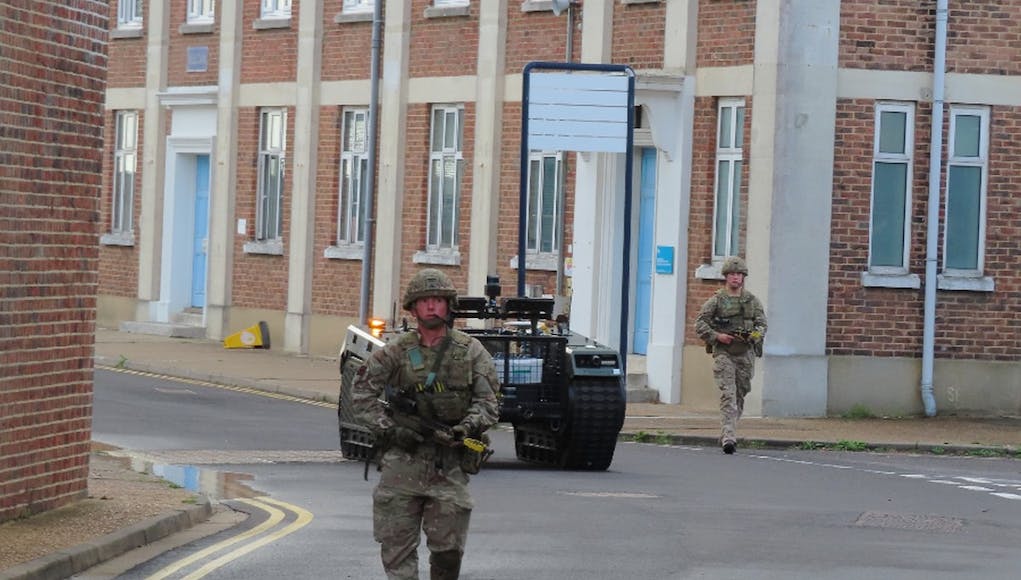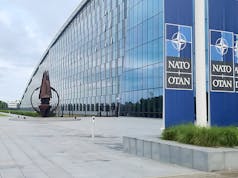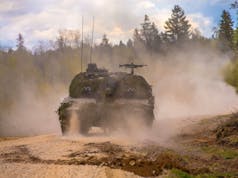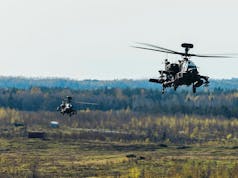British forces have conducted an urban military experiment, known as the Contested Urban Environment exercise.
The Ministry of Defence say here that during the event international and British scientists and engineers tested technologies that have the potential capability to find enemy forces in built up environments.
“The novel equipment was assessed alongside a whole host of futuristic technology by military personnel from 1 Intelligence, Surveillance and Reconnaissance Brigade, 1st Battalion The Rifles and 1 Artillery Brigade, in selected areas on the streets of Portsmouth and its Naval Base. The UK Armed Forces already train for and conduct urban warfare, but this type of experimentation is vital to understand and adapt to the changing warfighting environment. There are many challenges to finding and dealing with threats, such as those experienced when operating in and around dense, tall buildings and within modern urban areas or ‘smart cities’, and with differences of culture and language.”
Professor Dame Angela McLean, MOD Chief Adviser said:
“It was impressive to see the CUE21 experiment in action – testing this kind of technology is absolutely vital to better equip our Armed Forces. The collaboration with our allies means we are able to share technical knowledge to fight the battles of the future together.”
The UK and its ‘5-eyes’ partners: Canada, the USA, New Zealand and Australia are jointly working on this with industry and academia. Born out of The Technical Cooperation Programme, the 5 partner nations are testing novel technologies that seek to help our forces when operating in urban environments, including:
- highly distributed autonomous sensors that exploit artificial intelligence (AI) and machine learning (ML) to identify threats
- advanced technologies to support intelligence, surveillance and reconnaissance activities on the ground, in the air and at sea
- advanced sensors and technologies for detecting uncrewed air vehicles used in urban environments
- understanding the city environment and the interactions of natural and human systems
- technologies that support soldiers operating in dense urban terrain by supporting navigation, detection of threats
- robotic and autonomous systems to support logistics re-supply to deliver to the frontline
- casualty evacuation and handling optimised for the complexity of an urban environment














There were some really innovative bits of autonomous kit at DSEI this year. This is an area where the Army needs to really focus now, given its reduced size.
Considering how bad signals carry around built up areas and/or how easy it is to jam signals in a tight area, I suspect in realistic environments that these techs are not going to be the game changer that they are made up to be.
Whoever controls the electro- magnetic spectrum controls the Battle space Jamming, is the key strategy As you’ve stated Steve
This is, without doubt, the future Mike. Embrace it and move forwards at pace!
Money well spent in my opinion which will hopefully save countless lives.
Spot on Mike.
I’m all for exploring new technolgoes in which to aid our armed forces. But first (and a big first) I’d like them to furnish the troops with actual stuff (which works) and not etheral promises for equipment still on the design board with a TOS date years away. why I’d even be happy for a MP to be slipped a backhander for his role in acheiving that goal (Mind you, looking at the PMs love for China and Russia, I’d count him out)
Exactly. It’s all the future which never seems to quite arrive, until the next round of cuts.
As David said in another thread. Artillery. Armoured Vehicles. Cannons. ATGW. Air Defence Missiles. Long Range Rockets.
Things that actually kill/hurt the enemy.
I think we know that uncrewed systems work, they are being used successfully in civllian and military spheres every day. Its like asking for more horses or sailing ships (which work) during the industrial revolution. You will quickly get found out the first time a peer conflict comes along if you have not invested in AI and automation. Why? becuase these systems allow you to find and fix the enemy before they find and fix you, and take more risk and gain more mass at a lower cost. However good your weapons are, you can’t hit what you can’t see.
Systems like this MILREM UGV pictured can, for example, enable an unmanned fixed postion with ISTAR and a HMG – in an urban environment effectively setting up a CCTV net around the area to be defended (except with much better sensors). Carry heavy weapons into action with infantry – such as mortars, ATGMs, HMGs, autocannon or even Brimstone – proivide logs support for the last mile, go on point, probing ahead and taking fire rather than a solider, act as decoys to spoof the enemy etc. etc.
All sounds lovely in principle but when the Army are only putting HMG’s on their new fancy top of the range armoured vehicles do you honestly think they are going to put any heavy weapons on these stations… and then leave them isolated with no dismounted support for remote ISTAR?
In close quarters with restricted manoeuvrability such as pictured above, eyes will always be better than cameras. Can’t see it myself. Certainly not in the above environment.
The MK1 eyeball will never be replaced by automation.
I agree in principle with you that modernisation is the way forward but it has a place, and so do boots on the ground with IW’s.
Last mile logistics is tricky as well. Mechanical breakdowns, comms issues, terrain suitability etc can all be avoided by the good old tried and test method of screaming at crowbots to hump heavy shit around the battlefield.
Now replacing remf’s with this is a different matter I suppose… Operating in an uncontested area…
Remf’s can at least clean the lattrines without short circuiting
The Milrem Themis drone in the picture above, is something the Army could have tomorrow. It has been used in Operations is Mali by the Estonians. For what that version is designed to do I think it would be a great asset, which is basically a mule to carry heavy kit, such as Bergens, ammo, food, water etc. So in that role it is used within line of sight of the operator. It uses a hybrid diesel-electric engine, so can be nice an quiet when needed. A big plus is that you can fit two side by side stretchers on top of it, so no more lugging someone around back to an aid post or a helispot.
For something a bit more complex like their Type X vehicle, you will need lots of robust comm’s with plenty of redundancy. Preferably using a UAV as data-link relay. However, you better have plenty of spare UAVs as they will be a primary target for anyone operating in the field.
Looks to me like the Army are becoming more ambitious with the role of this sort of tech. Is this the start of a complete overhaul of the modern battlefield?
And consign Bata bootmakers too history
If it follows the same path as tech introduction in every other area it might eventually double the effectiveness but you will need 5 times the number of people with exotic job titles and twice the money plus the original guys obviously get a promotion and spend half their lives on training cources.😀
When I was in the Andrew someone supposedly worked out that for every 1 frontline person there was 4 support staff on twice the wage
Yeah they need to rethink the whole process. Giving a re-assessment of the skills people are bringing to the job is the way to go rather than a %age increase is the way to go..
Military is bad though. In many other industries they are more efficient but obviously sill have people supporting those in the frontline.
IF Civilian support staff were too be made up of,ex service personnel could waste be halved or doubled ?
Having the right person with the right skills for the specific role (and motivating them properly) is the key. There are some roles where ex service personnel would fit nicely and their experience & skills would be a great asset. Other roles maybe not so much. It depends on the role and the person.
Mark ,I quite agree with what you have posted, allocation of ex personnel who have experience in areas Such as Stores accountancy, know precisely what is required, for frontline personnel, amount needed cost, and wastage if any ,but like you’ve put Other jobs would suite Civvies ie Tea,trolley Operator
Ideal area for ex personnel. I can see why the MOD might want that type of operation outsourced nowadays and they are far more open to small companies bidding for such work especially if the people can show they know what they are talking about. It would probably help if they can make their own tea😀
The tendering and then outsourcing too smaller companies could result in expenditure forever creeping up if there’s fixed time and costs are not set and then kept too it’s a shame but there are people and companies that see government monies as an a tap that never gets turned off not even when making Tea 🫖🍵
Oddly when Government departments total up the costs of outsoucing (which may seem high) they then have to compare them with the costs of doing it in-house (including the hidden costs we were talking about earlier) and it often turns out it is cheaper to outsource. The difference is probably more than just getting someone to make the tea.
Watch out for a move away from the big companies which just outsource to smaller companies. SMEs are becoming popular again.
Cool groovy new tech for the Army. What its actual practical use will be, well who knows.
Good news for the tory government though, in so far as it will assist them in saving money in the interim, by cutting back even more on recruitment and retention.
Then when it is finally acknowledged that this tech has limited use, they will no doubt announce an expansion in the Army, and start recruitment back to what the current levels should be.
Bean counters, tories and forward thing … you gotta love em!
Much of this technology is mature. I worked in the Robotics/UGV Division at RARDE in 1990-91. We were at least 10 years ahead of civilian Industry R&D, if not more. However the Army wasn’t interested in most of our Technology Demonstrators. I hope that the Army is more receptive now.
exterminate……..Exterminate…….EXTERMINATEEEEEEEEEEEEEE!!!!!!!!
Better get the word out and warn Sarah Connor ,